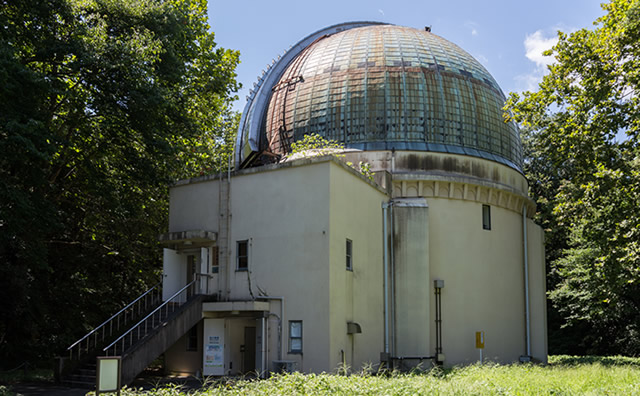Observatory History Museum
The 65-cm Telescope Dome

The 65-cm (26-inch) Refractor Telescope installed in the dome was manufactured by the German company Carl Zeiss and has the largest aperture among refractors in Japan. After its installation in 1929, this telescope was used for various observations as Japan’s largest-aperture telescope until 1960, when the 188-cm (74-inch) Reflector Telescope of Okayama Astrophysical Observatory (OAO) was built. The 65-cm Refractor Telescope specialized in measuring the positions of stars, a field in which a long-focal-length (or long-tube) telescope has a comparative advantage.
The observation floor (the red-brown central part of the second floor) could move up and down like an elevator according to the angle of the telescope tube, allowing astronomers to look through the telescope in a relaxed posture no matter what elevation it was tilted to point.
The telescope retired from research in March 1998 and has since been preserved as a historical monument of Japanese astronomy. The once movable observation floor was fixed in 2000.
Although it retired from observations due to aging, the building reopened in spring 2001 as the Observatory History Museum, where visitors can learn the history of astronomy and sky observation. The museum also hosts an exhibition of facsimiles of rare documents from NAOJ’s collection. (The exhibition theme changes twice a year.)
In February 2002, the building was listed as a Registered Tangible Cultural Property of Japan.
About
| Aperture | 65 cm (26 in) |
|---|---|
| Focal Length | 1021 cm (33 ft) |
| Purpose | Photographic and spectroscopic observations of celestial objects |
| Size | Diameter: 14.5 m (48 ft), Height: 19.5 m (64 ft) |
|---|---|
| Status | Registered Tangible Cultural Property |
| 1926 (Taisho Year 15) | Completed |
|---|---|
| 1929 (Showa Year 4) | 65-cm Refractor Telescope installed |
| 1998 (Heisei Year 10) | Retired from operation |
| 2001 (Heisei Year 13) | Opened as the Observatory History Museum |
| February, 2002 (Heisei Year 14) | Listed as a Tangible Cultural Property |